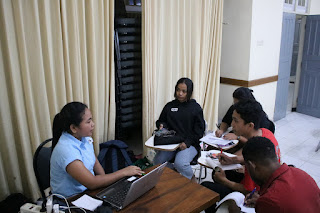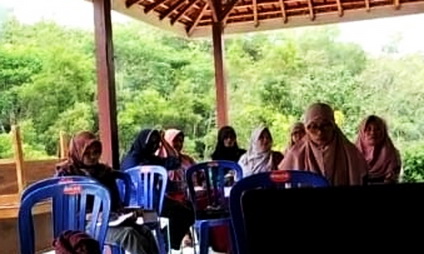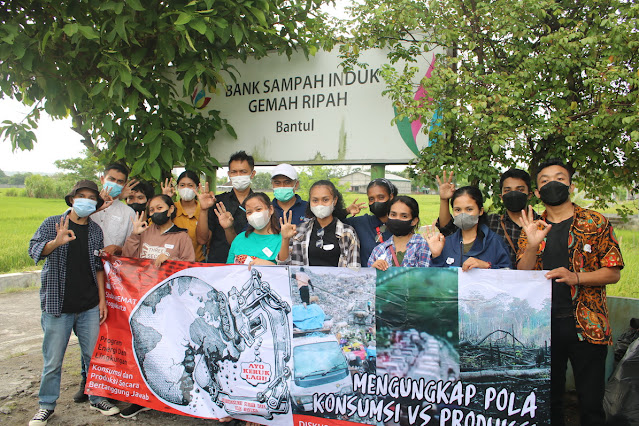By Daniel.
Have you heard about ‘Reshik’ noodle? This name is not yet commonly heard. Indeed, the popular name is actually 'lethek' noodle. ‘Lethek’ means dirty or dull, because the appearance of the noodles is not white or bright yellow. The term ‘Reshik’ with the meaning of clean, is a way to promote and to rebrand cassava-based noodles so that consumers are curious and 'literate' about locally made and low-gluten food.
The processing of ‘Reshik’ noodles is an activity of Stube HEMAT Yogyakarta in a series of Food Diversity: Local Food Initiative programs to convince young people and students that local food has prospective and healthy business opportunities. This exposure activity to process ‘Reshik’ noodles was held at the resto and factories of ‘Reshik’ noodle with ‘Dokar’ brand in Poncosari, Srandakan, Bantul, Yogyakarta Special Region (12/16/2023). Students must get to know the potency of local food in Indonesia because the Ministry of Agriculture notices that Indonesia is rich of potency with 77 sources of carbohydrates, from corn, potatoes, sweet potatoes, rice, cassava, sago, sorghum and other types. Even students are expected to have the skills how to process them into ready to process and even ready to eat products.
This exposure or study visit opens students' insights how to process cassava into healthy noodles because it is low in gluten and students practice to cook boiled and fried noodles. The students met the owner of ‘Reshik’ noodle with ‘Dokar’ brand, Fx. Subeno. He said that the achievement to this point was a long process in his life, from wandering with various jobs to finally working to produce noodles. Initially he only supplied flour for noodle and cracker factories, but since 2014 he started a noodle-making business under the name ‘Talang Berkah Jaya’ under the label of ‘Reshik’ noodle with ‘Dokar’ brand.
He explained the stages of making ‘Reshik’ noodles, from the very beginning stage by soaking cassava flour to get clean flour, then adding clean tapioca flour with a composition of 40:60. Then this mixture is ground for two hours using a special design machine until the dough is well mixed. Then with a certain thickness the dough is steamed until cooked and ground again until it is completely chewy. The next stage is to mold the dough into long granules, steam and drain for one night. From the indoor stage, the next process is to dry the noodles under the sun until they are completely dry. The final stage is packaging based on weight. The production process of two tons of ‘Reshik’ noodles takes about three to five days depending on the intensity of sun exposure.
From the observation of noodle production, the participants were invited to practice cooking with FX Subeno. He guided each participant to cook boiled and fried noodles covering preparing utensils and ingredients, measuring seasonings, and cooking steps and length of cooking. It turned out that not all participants achieved good cooking results, some were overcooked and some were not evenly mixed, but it did not reduce the enthusiasm of the participants for them to learn and enjoy their cooks. FX Subeno also explained the prospect of ‘Reshik’ noodle becoming a culinary business with local, healthy ingredients and unique flavors.
This exposure experience is opening an alternative job for students, especially by utilizing the potential of local food in their respective regions, related to cassava cultivation, utilizing post-harvest, and even processing cassava-based ingredients into ready-to-eat products. It's time for young people to work! ***











.jpg)






.png)





.jpg)

















.jpg)



.png)

.png)

.png)










.jpg)
.jpg)


.jpg)
.jpg)
.jpg)






























.jpg)







.jpeg)

.jpg)
.jpg)






.png)





.jpg)




















.jpg)
.jpg)





.png)













.png)
.png)


.png)
.png)
.png)
.png)
.png)
.png)
xyy.png)
%20-%20Copy.png)










.png)

.png)










.png)


.png)










































.png)








x.png)











.png)















.png)

.png)
.png)

.png)
.png)
.png)












































Nutrition sufficiency and public health depend on the quality of consumption. The globalization era led to changes in lifestyle and diet so that Indonesian people face multiple nutritional problems. On one hand, malnutrition problems are generally caused by poverty, lack of food supplies, or low understanding of nutrition. On the other hand, they can be ignited by an economic factor at certain levels of society but not balanced with knowledge about nutrition with a balanced menu, so they ignore their consumption to fulfill their desires. People daily consumption tend to consume risky foods for their health, such as high levels of sugar, salt, and fat and minimal elements of vegetables and fruit.
This consumption pattern also threatens students during the pandemic because many online activities from boarding houses or homes so outdoor activities are reduced. The phenomenon that occurs is that the longer people are in a pandemic situation, the level of 'laziness' or lazy to move is increasing. Indirectly, this condition affects careless eating patterns, irregular rest time, and inappropriate nutritional intake for the body's needs. Students frequently complain of stomach pain, acid reflux, obesity, and malnutrition.
Understanding healthy living behavior by paying attention to consumption patterns is a crucial point to know. In the Energy and Environment program: Responsible consumption and production, Stube HEMAT Yogyakarta initiated the discussion activity 'Revealing consumption patterns of young people, physical activity and obesity during a pandemic' with Ir. Ferry Fredy Karwur, M.Sc., Ph.D., as the resource person. The discussion participants were students with various study backgrounds, from Education, Governance, Engineering, Management, Communication, and Theology, they found enlightenment and enrichment of knowledge related to consumption patterns of young people (5/3/2022) at Wisma Pojok Indah, Condongcatur. He started the session with exercise to campaign the importance of the body burning fat and morning sun exposure. This outdoor activity made participants feel tired, and relaxed body, some were sweating and some did not. He revealed that the pandemic made students fall asleep in the room without activity and neglected nutritional intake. The current health threat is that food tends to contain high sugar. Hence, the accumulation of glucose in the body potentially causes health problems from obesity, diabetes, and high blood pressure.
The data on cases of death due to Covid-19 are dominated by those over 46 years of age. From other data, patients dying from Covid-19 accompanied by comorbidities, hypertension, diabetes, heart, kidney, and lungs are in the top five highest cases. It seems that the younger age group is more 'safe' from the impact of being exposed to Covid-19, but keep in mind that comorbidities that aggravate Covid-19 cases are diseases caused by the accumulation of someone's unhealthy lifestyle. So, if someone cannot manage nutritional intake and a healthy lifestyle since young, degenerative diseases will attack.
One threat that cannot be considered 'trivial' is obesity among young people, which is influenced by age, eating in excessive portions, wrong consumption patterns such as eating out of meal times, minimum physical activity, heredity, disturbances in the body's heat production due to wrong sleep patterns due to being more active in cyberspace, also due to increased stress.
The Director of Stube HEMAT said, "After getting new knowledge of controlling a quality lifestyle, you should start making changes as a sign that you all have learned." In closing the discussion, the participants stated that this training made their understanding more open and observant to the reality of observing every daily behavior and attitude in terms of more responsible consumption and production.***